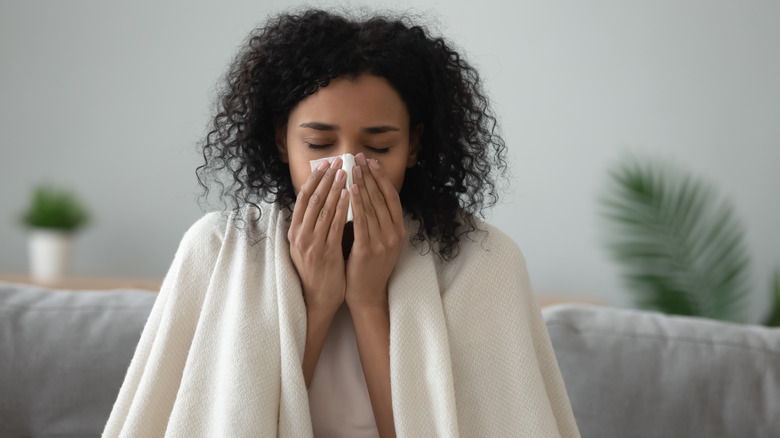How To Tell The Difference Between A Cold And COVID-19
As we get closer to the winter season, we may be wondering how to tell the difference between a common cold and COVID-19. Unfortunately, experts warn symptoms are similar for both, which may cause confusion. So let's first address how they're similar. Both are viruses that can spread from person to person. Either the cold or COVID-19 may cause the following symptoms: cough, sore throat, and runny nose. Note that when it comes to a cough, COVID-19 is marked by a dry cough in particular. Other symptoms that can happen in either, but that are less commonly associated with the cold, are: muscle aches, tiredness, and loss of taste or smell. The loss of taste or smell for those with a cold may be a result of congestion.
So what are the differences? Symptoms that are not associated with the common cold, but are highly associated with COVID-19, are diarrhea, nausea, and vomiting, via Mayo Clinic. Additionally, fever is highly associated with COVID-19 and rarely associated with the common cold, via Medical News Today. Another big distinction is when symptoms begin to appear. Symptoms for COVID-19 tend to appear 10-14 days after exposure, whereas cold symptoms typically appear 1-3 days after exposure.
When to seek medical attention
While the cold can be self-treated at home and relatively benign, COVID-19 can cause more adverse health complications, especially in immunocompromised individuals. However, those with mild symptoms of COVID-19 can expect to recover at home as well, via the CDC. Guidelines suggest that those who suspect they have COVID-19 should self-isolate (as much as possible), stay hydrated, and take over-the-counter medications to ease symptoms. The CDC warns that COVID-19 symptoms indicative of a medical emergency include difficulty breathing, chest pain or pressure, confusion, pale or gray skin, and blue lips or nail beds. If a medical emergency is suspected, call 911 or call a local emergency facility, letting them know you're needing care for COVID-19 symptoms. Mayo Clinic suggests that colds likely only need medical attention if a fever goes above 101.3, or you experience shortness of breath, wheezing, a severe sore throat, or symptoms that get worse (as these may be indicative of something more than a cold). Additionally, you may need to seek treatment if you are symptomatic of co-occurring infections like an ear infection or sinusitis.


